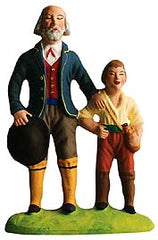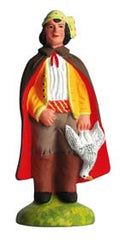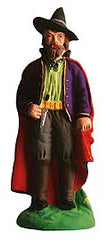- Carbonel Santons
∨
- Size Guide / Puce through Size #3
- Size Puce (Chip/Flea) - 1" >
- Size Guide / Puce through Size #3
- New
- Stables
- Accessories
- Biblical
- Animals
- 20 Essential
- Women
- Men
- Children
- Couples
- Shepherds
- Fishermen
- Religious Folk
- Older Folk
- Provinces
- Gypsies
- Musicians/Dancers
- Townspeople
- With Animals
- Walks of Life
- Women with Offerings
- Men with Offerings
- Carbonel Brochure Size Puce (Flea)
- Carbonel Brochure Creches and Accessories
- Dictionary
- Size #1 (Cricket) - 1-5/8" >
- Size Guide / Puce through Size #3
- New
- Special Creche Sets / Save
- Stables/Houses
- Accessories
- Biblical
- Animals
- 20 Essential
- Women
- Men
- Children
- Couples
- Shepherds
- Fishermen
- Religious Folk
- Older Folk
- Provinces
- Gypsies
- Musicians/Dancers
- Townspeople
- Literary
- With Animals
- Walks of Life
- With Offerings
- Carbonel Brochure Size #1 Cricket
- Carbonel Brochure Creches and Accessories
- Dictionary
- Size #2 (Elite) - 2.75" >
- Size Guide / Puce through Size #3
- SALE
- New
- Stables/Houses
- Accessories
- Biblical
- Animals
- European Miniatures for Size #2
- 20 Essential
- Men
- Women
- Children
- Couples
- Shepherds
- Fishermen
- Religious Folk
- Older Folk
- Provinces
- Gypsies
- Musicians/Dancers
- Townspeople
- Literary Figures
- With Animals
- Walks of Life
- With Offerings
- Carbonel Brochure Size #2 Elite
- Carbonel Brochure Creches and Accessories
- Dictionary
- Size #3 (Grande) - 3.5" >
- New
- Creche Set / Save
- Stables
- Accessories
- European Miniatures for Size #3
- Biblical
- Animals
- 20 Essential
- Men
- Women
- Children
- Couples
- Shepherds
- Fishermen
- Religious Folk
- Older Folk
- Provinces
- Gypsies
- Musicians/Dancers
- Townspeople
- Literary Figures
- With Animals
- Walks of Life
- With Offerings
- Carbonel Brochure Size #3 Grande
- Carbonel Brochure Creches and Accessories
- Dictionary
- Trees >
- Angels
- Illustration of Figure Sizes Puce through #3
- Illustration of Heights within a Figure
- Inge-Glas ∨
- Wendt & Kühn
∨
- SALE
- New for 2025
- New for 2024
- Grünhainichen Angels
- Marguerite Angels
- Orchestra Musician Angels
- Gold Edition Angels
- Angels with Crowns
- Nativity Set
- Christmas / Madonnas / Angels
- Santas / Pixies / Gnomes
- Ornaments
- Winter Children
- Celebrations / Birthday / Anniversary, etc.
- Easter and Spring Collection
- Flower Children (Blossom Kinder) and Friends
- Replacement Flowers
- Berry Pickers
- Fairy Tales
- Trees >
- Animals
- Accessories
- Display Mountains and Meadows
- Slumber Vaults / Splinter Boxes / Gift Boxes / Storage
- How the Angel Got Its Eleven Dots Book
- Calendar
- Napkins
- Send Wendt and Kühn ecards
- European Folk Art ∨
- German Christmas ∨
The Blind Man and His Son - the No. #3 "Essential" Santon for a Provençal creche
Posted on December 06, 2012 | 0 Comments
In March 2012 we published Essential Santons for a Provençal Creche - a list of the top 20 Santons included in the creche by the Provençal people. The Blind Man and his Son - l'Aveugle et son fils (French) – L'avugle e soun fieu (Provençal) was the third most important Santon to be included in the Provençal creche and is available in all four Marcel Carbonel Santons sizes offered by My Growing Traditions.
The Santon of the Blind Man and his Son was derived from the seemingly hopeless tale of these two central figures in the Pastorale of Antoine Maurel.
Pastorales are Provençal Christmas tales that tell the story of the birth of Christ. They are presented each year by Provençal villagers and are a part of the oral history passed down from generation to generation on Christmas Eve. The Provençal nativity uniquely consists of the biblical characters in traditional biblical dress with typical Provençal village characters, in 19th century dress, who have come to the manger to celebrate Jesus' birth. Written in 1844, Maurel's Pastorale is the most famous of the pastorales and was first performed at the Cercle d'Ouvriers - Catholic Circle of Workers (to which Maurel was a member ) in Marseille.
Having lost his sight years before in grief when an older son, Chicoulet (available in all but Size #1 [Cricket] of the four Marcel Carbonel sizes offered by My Growing Traditions),
was abducted by the Highwayman - Brigand (French) (also known as the robber and often confused with a gypsy).
The Blind Man, dressed in a spencer jacket with yellow braiding, travelled to the manger with his young son Simon (Simoun). Simoun was intent that his father should in the presence of the Saviour ask for his sight to be returned.
As Daniel J. Foley explains in his 1959 Little Saints of Christmas: The Santons of Provence:
The Blind Man "became a symbol of humility and patience. He was at the manger to thank the Good Mother for consoling the sick and afflicted. He felt that the Light of the World was within him, and even though he could not see the sky and the world about him, he knew it was beautiful because God made it so. He asked not for his sight on this earth, but that he might be granted vision when he reached the next world. He hoped that the time was not far away, for in his humble faith he believed in Paradise and the angels and, though blind, he wanted to see them." - p. 18
Being rewarded for his humble heart, his sight is returned at the manger. He discovers and is reunited with Chicoulet, and at the manger the Highwayman admits that it was he that kidnapped Chicoulet.
Posted in Carbonel Santons, Provence Christmas
Next →
← Previous
Leave a Reply
Subscribe via Email
Recent Articles
-
The Tradition of Tinsel - the Legend of the Christmas Spider
November 28, 2025
-
New Wendt and Kuhn figures available to Pre-Order Now
February 16, 2025
-
The Story of Marcel Carbonel Santons
November 10, 2024
-
Angel with Gift for Mother's Day
April 26, 2024
-
So Many Ways to Add Eggs to Your Easter Celebration
March 13, 2024
Tags
- About Us (0)
- Advent (2)
- Angels (14)
- Bettina Franke Workshop (1)
- Birds (0)
- Brück and Sohn (1)
- Carbonel Santons (4)
- Christian Ulbricht (0)
- Christian Werner (0)
- Christmas Candles (0)
- Christmas Legends (3)
- Christmas Traditions (11)
- Dala Horses (0)
- Easter (1)
- Emil Helbig (2)
- Erzgebirge (13)
- Esco (0)
- Fairy Tales (2)
- French Christmas (5)
- German Christmas (8)
- German Folk Art (25)
- German Traditions (7)
- Gnomes and Pixies (2)
- Inge-Glas (2)
- Nativities (4)
- Noah's Ark (0)
- Provence Christmas (3)
- Sale (2)
- Santa (1)
- Scandinavia (0)
- Spring (1)
- Trees (3)
- Valentine's Day (5)
- Wendt and Kühn (21)
- Winter Solstice (0)
- Zeidler Holzkunst (0)



















